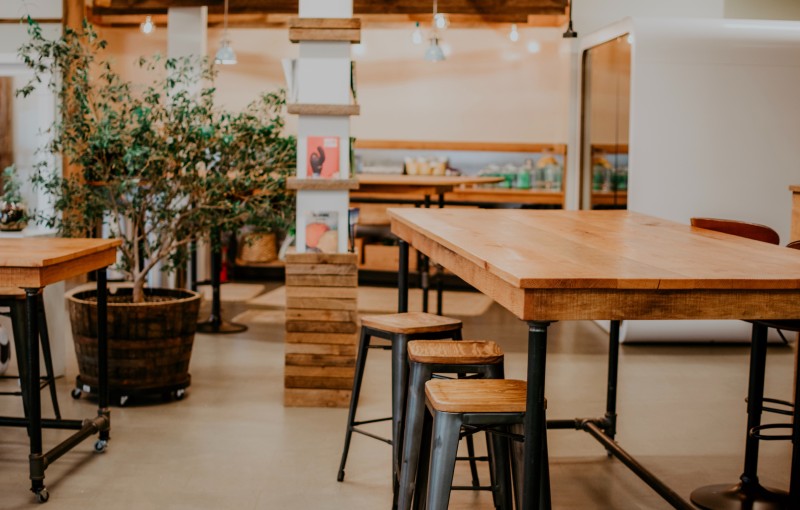Office guidelines during Corona and 1.5-meter economy

Recently, many countries announced that the new 1.5-meter society will last a long time, in order to control the corona crisis until there is a vaccine. This has consequences for the entire economy, and this is a major challenge for employers. Many employees currently work at home as much as possible, on the strong advice of the government. In the short term, this is a good and safe solution. But in the longer term it is of course desirable that everyone can go to the office, which also increases productivity. As a company, how do you ensure that the one-and-a-half-meter distance for your employees is properly maintained? How do you make the office as Corona-proof as possible?
The way to your workplace
When entering the building, you must of course also be able to reach your workplace in a safe way. So, a very limited number of people can use the elevator at the same time, please indicate this at the entrance of the elevator. A healthier way is to take the stairs, here you can more easily observe the one-and-a-half-meter distance rule. Although 'oncoming traffic' on the stairs often remains a challenge.
Make sure to rearrange your office

In most offices, people are generally closer together than 1.5 meters. In the new society this is no longer an option and a minimum distance of 1.5 meters must be maintained. Therefore, pull the desks apart and make separate blocks. Pay close attention to whether the walking routes to their workplace are the right distance and how the internet and power cabling runs.
Visual instructions
In addition to the distance between desks, it is important to make employees aware of the distance to be maintained. We therefore recommend to show this visually. Indicate with lines on the floor how large everyone's personal workstation is. Let there be no doubt or ambiguity about this. You can also work with arrows on the floor, which indicate the walking route. In this way you stimulate one-way traffic so that no one runs the risk of colliding with each other.

We use a straight line tape in our office. We have already seen this at several offices in Amsterdam.
Use partitions or desk screens
A space-saving addition to divide your office is the use of handy partitions. This can be in the form of glass acoustic partitions that form a closed unit. These walls are flexible to move around on the work floor, depending on the wishes of the moment. Another option is a desk screen that you place between two desks that are opposite each other. In addition to the fact that these screens reduce the risk of contamination, they are also sound absorbing, something that may come in handy after this crisis.
Flexible workplaces
Flexible workplaces within offices have been hugely popular for some time now. Fewer and fewer people have a fixed workplace and coworking is also becoming increasingly popular. Will corona put an end to this trend of flexible workplaces in offices? Fortunately, this is not necessary, because there are several ways to make these offices corona proof as well. There are smart ways to decontaminate a flexible workplace during the day, so that it can be used safely by another employee. This can be done by means of recyclable (paper) placemats, which employees place on the desk before they start working. All work materials, from laptop and mouse to glasses and plates, are placed on these placemats. When the employee leaves the workplace, he throws the placemat away and cleans the table for extra control. Extra tip: promote the corona rules on the place mat, an extra option to keep your employee extra alert!
Hygienic measures

The most practical, but also extremely important advice, is hygiene. Make sure that all your employees are aware of the following hygiene measures. Give someone the responsibility to check that these are adhered to:
- Always clean door handles after use, and also four extra times a day with cleaning spray. Make a time schedule for this that must be ticked/checked every time.
- Make sure that disinfectant soap is always present on all sanitary facilities and remind your employees of frequent hand washing. For example, set up a 'hand wash' station at a prominent place in the office.
- Make sure there is sufficient stock of disinfectant wipes and plastic gloves.
- Replace towels with kitchen paper, which is discarded immediately after use.
- Provide mouth caps, for anyone who wants to work extra safely on the work floor.
- Clean your mouse, keyboard and smartphone at least twice a day with a disinfectant cleaner.
- Emphasize once again how important it is to cough and sneeze in the inside of your elbow.
- Close the toilet lid when flushing. When you flush with the lid opened, it is possible that virus particles will float in the air for a long time. This WHO advice is considered just as important as, for example, sneezing in the elbow.

Air handling and air-conditioning systems
We know that the Covid-19 virus is transmitted by sneezing and coughing, by particles that remain in the air for some time. It has not (yet) been established whether the virus is also transmitted by air. Precisely because this cannot be ruled out, precautions regarding air circulation are smart to follow. There are no scientifically proven guidelines yet, but research has been carried out by specialists such as the REHVA (the European Association for Ventilation and Air Handling Systems) REHVA advocates several precautionary measures that reduce potential risks. On this basis, we recommend the following:

- The most important advice given is to stop central air re-circulation. This means that there is re-circulation of indoor air. As a result, virus particles in air outlets can re-enter the room. To prevent this, the re-circulation sections must be closed from the building management system, or manually.
- This advice also applies to decentralized re-circulation systems such as induction units and fan coil units. Where fresh air is not blown in and dirty air is extracted, you should be more careful. If the system has no function of ventilation and only serves to determine the temperature in the room (hot/cold), it is advisable to turn these systems off.
- Does your office have an air ventilation system? If so, make sure it is on for as long as possible so that it is well ventilated. It is best to keep it at the highest setting for 24 hours. This is important in order to get as much new air supply from outside as possible. If you do not have a system, open the windows for fifteen minutes before your employees arrive and let the room air as much as possible.
- Do research into good air cleaners. Air cleaners with a so-called HEPA filter do the same as a ventilation system. However, you will need several of them to clean the entire room with them.
- If your office does not yet have air conditioning, it is wise to buy them anyway. Modern air conditioners contain filters and a special air purification function. These filters remove pollen, harmful substances, bacteria and other pollutants such as virus particles from the air. Even when the air conditioner does not have a special air purification function, the air in the office will still be cleaner.
Company lunch during Covid-19
Many companies offer lunch during the break arranged by the employer. However, meetings in large groups is no longer an option, so what are the possibilities to make the company lunch corona proof as well? The most obvious answer is to opt for shifts. Let employees have lunch in small(er) groups, and make sure that the lunch table offers enough space to keep the 1.5 meter distance. Here, too, walking routes and hygiene rules must be maintained. Use disposable plates and cups and have someone check that table and chairs are cleaned after a lunch shift.
Separate office supplies
Cleaning or disinfecting office supplies several times a day is strongly recommended. But also make sure that employees keep their mouse, keyboard, headset and other work items for themselves. This can be done, for example, by stickers on the office supplies so that everything is kept well apart.
Facilitate meetings
Until corona, meetings were easy with 10 people around a table. However, most meeting rooms will not offer enough space to keep the distance. Instead of 10 employees, only a few people will fit in a room. This makes it important for employees to be able to take part in the meeting from another room and for this to run smoothly. In order to facilitate this, there are sufficient possibilities that have already been frequently used during the current crises. Think of Microsoft Teams or Zoom. Different participants can still attend the meeting from their workplace or somewhere else in the office. Invest in this so that you are prepared for a future in which the 1.5 meter at the office will continue for some time to come.
Rent extra office space
It is not possible to apply the 1.5-meter distance rule in every office. This can be the case, for example, when the space does not allow to spread desks. In this case, there are alternative options with which you can still ensure a safe and healthy working environment. The first option is to rent extra office space from your current landlord. This way you keep the team at the same location and apply the one-and-a-half-meter rule.
Divide the team into shifts
Of course, renting extra space also involves additional costs. One option that is already being integrated by many companies is to divide the team into shifts. Fewer people come to the office at the same time, so that employees have more space at the office. The other half works from home. It is good to adjust this schedule on a weekly basis, so that everyone has the opportunity to come back to the office.
Moving team to plug and play
You can also choose not to have part of the teamwork from home, but to move to a flexible work location. This move could be to business centers, where your employees only need to bring a laptop and can start working immediately. This is especially useful because these rents are flexible. As soon as times change again, you can switch instantly and get rid of the temporary office space again.
Get advice from Flexas.com
Every company is different and may look different after this crisis. That is why a tailor-made solution is required. It can be a huge relief to hire an office space specialist such as Flexas.com to advise you on your personal situation. This will enable you to make a quick inventory of your possible office problem and to look for the best solution for your company.
How many m² of office space do I need per workstation?
Flexas.com works with a self-developed tool, with which you can easily calculate how much space in square meters you need for your company. It includes the standards needed to provide employees with a healthy workplace. Especially for the new 1.5-meter economy, we have adapted this tool to the Covid-19 guideline: 'extra wide'.


